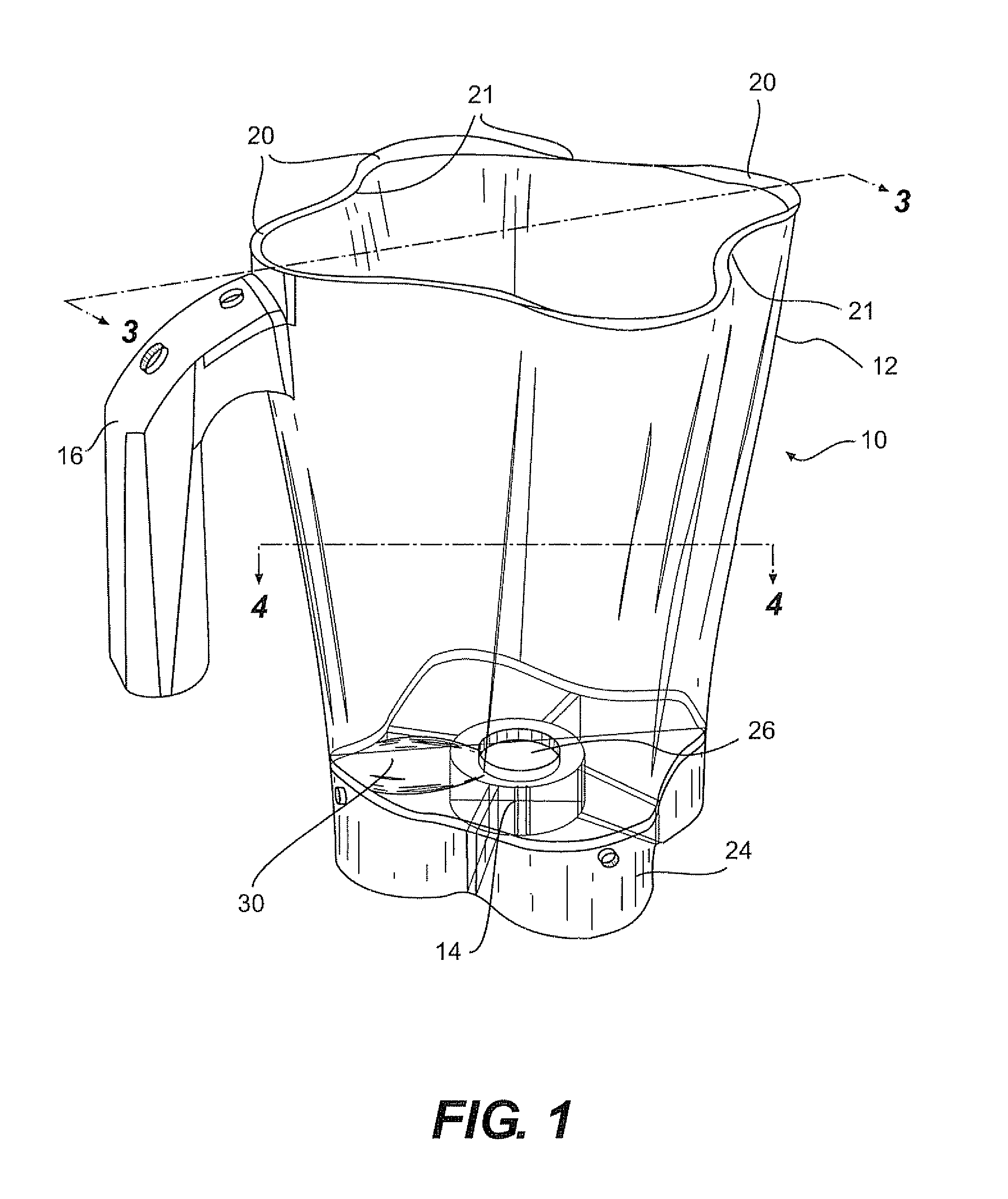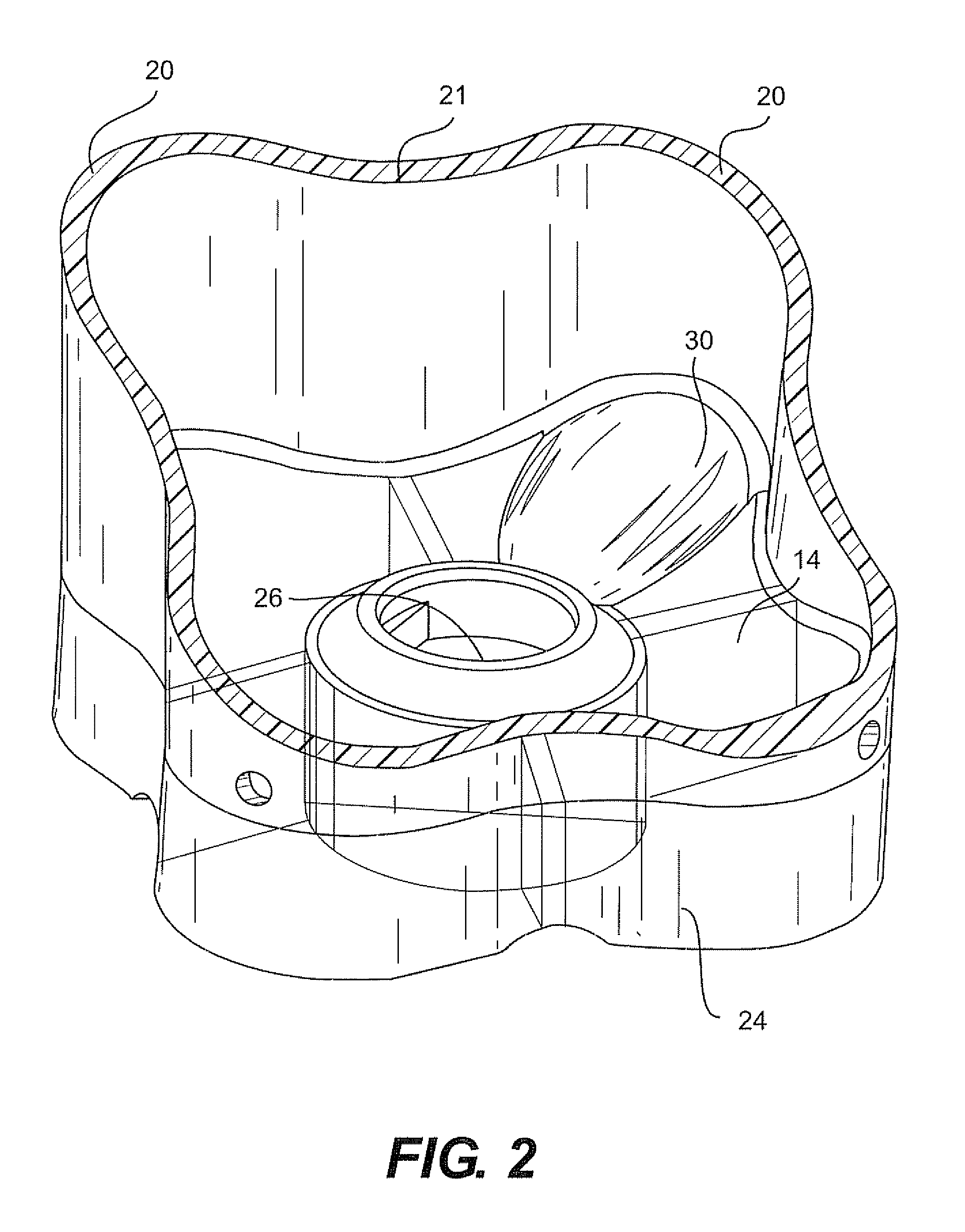Dispensing Blender Jar
a technology for blenders and jars, applied in the field of blender jars, can solve the problems of manual work that requires user attention, design may put extra strain on the blender motor, and effort also has limitations, so as to improve the horizontal flow of material, promote three-dimensional material flow, and improve the geometry of the blender jars
- Summary
- Abstract
- Description
- Claims
- Application Information
AI Technical Summary
Benefits of technology
Problems solved by technology
Method used
Image
Examples
example 1
(FIGS. 1-4)
[0044]FIGS. 1-4 illustrate a substantially four-sided blender jar 10. The jar 10 has four sides 12 that make up the sidewall of the jar. The jar 10 has rounded vertical corners 20 and vertical bumps 21 along the vertical length of the jar. The floor 14 of the jar 10 is generally smooth and primarily embodies a revolve geometry to promote laminar flow in the circumferential direction on the floor during operation. The jar 10 includes a handle 16. The bottom portion 24 of the sidewalls 12 is adapted to be received in a blender base to secure the jar while the blender motor is operated to rotate a cutter assembly. The floor 14 also includes a central opening or aperture 26 through which extends a drive shaft 35. The drive shaft 35 has a cutter assembly 36 mounted onto it.
[0045] The floor 14 also includes an agitator in the form of a horizontal hump 30. The hump 30 is substantially the length of the radius of the jar from the central opening 26 to the sidewall 12. The heig...
example 2
(FIGS. 5-8)
[0048] Another example of a blender jar is shown in FIGS. 5-8. The jar 50 has a fundamentally round sidewall cross-section with two vertical bumps 53 on one side of the circular cross section. The floor 56 is curved in substantial part in a revolve geometry There is a handle 54. The bottom portion 58 of the sidewall 52 engages a blender base via the outside geometry of the jar (at the bumps) and a series of ribs and / or slots on the base of the, jar to hold the jar secure during operation.
[0049] The floor 56 includes multiple agitators, specifically, three surfaces 57 and 59 that disrupt laminar flow around the jar 50 in the circumferential direction. In this example, the pair of surfaces 57 are generally similar to each other. The surface 59 is similar in function the surfaces 57, but the surface 59 has slightly different geometry in that it is configured between the two bumps 53 and the sidewall 52. The surfaces 57 and 59 are substantially flat planes that are closer ...
example 3
(FIGS. 9-12)
[0053] A still further example of a blender jar is shown in FIGS. 9-12. Like the jar 50 shown in Example 2, jar 70 has a fundamentally round sidewall cross-section with two vertical bumps 73 on one side of the circular cross section. The floor 76 is curved in substantial part in a revolved geometry. There is a handle 74. The bottom portion 78 of the jar 70 engages a blender base to hold the jar secure during operation.
[0054] The floor 76 includes multiple agitators, specifically, three surfaces 77 and 79 that disrupt laminar flow around the jar 70 the circumferential direction. In this example, the pair of surfaces 77 are generally similar to each other. The surface 79 is similar in function to the surfaces 77, but the surface 79 has slightly different geometry in that it is configured between the two bumps 73 and the sidewalls 72. The surfaces 77 and 79 are substantially flat planes that are closer to the blades 80 and the blade path formed by the rotation of the bla...
PUM
 Login to View More
Login to View More Abstract
Description
Claims
Application Information
 Login to View More
Login to View More - R&D
- Intellectual Property
- Life Sciences
- Materials
- Tech Scout
- Unparalleled Data Quality
- Higher Quality Content
- 60% Fewer Hallucinations
Browse by: Latest US Patents, China's latest patents, Technical Efficacy Thesaurus, Application Domain, Technology Topic, Popular Technical Reports.
© 2025 PatSnap. All rights reserved.Legal|Privacy policy|Modern Slavery Act Transparency Statement|Sitemap|About US| Contact US: help@patsnap.com



